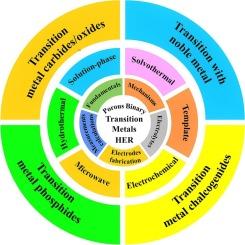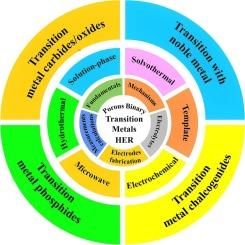Unravelling the structure-activity relationship of porous binary metal-based electrocatalysts for green hydrogen evolution reaction
IF 20.3
1区 化学
Q1 CHEMISTRY, INORGANIC & NUCLEAR
引用次数: 0
Abstract
Green hydrogen (H2) production through hydrogen evolution reaction (HER) via water splitting is deemed an efficient and sustainable fuel or energy carrier without environmental detriments. However, its higher cost remains the bottleneck in the commercialization process. Ubiquitously, porous binary metal-based catalysts so far remain the most active electrocatalysts for the HER, owing to their electronic effect, optimum hydrogen binding energy, and lower activation energies for H-desorption and recombination close to the thermodynamic potential. Despite plentiful efforts and developments, the engineering of porous binary metals for the HER still comprises numerous scientific problems to be unraveled, which still await deliberation. This review emphasizes the rational design of porous noble binary-metal-based electrocatalysts, porous transition binary-metal electrocatalysts (i.e., carbides/oxides, phosphides, chalcogenides) for the HER, both experimentally and theoretically (i.e., density functional theory (DFT) simulations and machine learning). Additionally, the associated mechanism, fundamental, and current interrogations (i.e., electronic effect, phase, strain, phase engineering, and interaction support) are highlighted related to porous bimetallic electrocatalysts for the HER. Eventually, a brief synopsis of the relevant milestones of current challenges and revitalizing perspectives to direct future research is presented aimed at developing effective porous binary metal-based electrocatalysts for large-scale HER applications.


揭示多孔二元金属电催化剂在绿色氢气进化反应中的结构-活性关系
通过水分裂进行氢进化反应(HER)生产绿色氢气(H2)被认为是一种高效、可持续的燃料或能源载体,不会对环境造成危害。然而,其较高的成本仍然是商业化进程中的瓶颈。由于多孔二元金属催化剂的电子效应、最佳氢结合能以及接近热力学势能的较低氢解吸和重组活化能,迄今为止,多孔二元金属催化剂仍是最活跃的氢进化反应电催化剂。尽管做出了大量努力并取得了长足发展,但多孔二元金属在氢转换反应中的工程应用仍存在许多有待解决的科学问题,这些问题仍有待深入研究。这篇综述从实验和理论(即密度泛函理论(DFT)模拟和机器学习)两方面强调了多孔惰性二元金属电催化剂、多孔过渡二元金属电催化剂(即碳化物/氧化物、磷化物、铬化物)在氢效率反应器中的合理设计。此外,还重点介绍了与用于 HER 的多孔双金属电催化剂相关的机制、基础和当前研究(即电子效应、相、应变、相工程和相互作用支持)。最后,简要概述了当前挑战的相关里程碑以及指导未来研究的新视角,旨在开发用于大规模 HER 应用的有效多孔双金属电催化剂。
本文章由计算机程序翻译,如有差异,请以英文原文为准。
求助全文
约1分钟内获得全文
求助全文
来源期刊

Coordination Chemistry Reviews
化学-无机化学与核化学
CiteScore
34.30
自引率
5.30%
发文量
457
审稿时长
54 days
期刊介绍:
Coordination Chemistry Reviews offers rapid publication of review articles on current and significant topics in coordination chemistry, encompassing organometallic, supramolecular, theoretical, and bioinorganic chemistry. It also covers catalysis, materials chemistry, and metal-organic frameworks from a coordination chemistry perspective. Reviews summarize recent developments or discuss specific techniques, welcoming contributions from both established and emerging researchers.
The journal releases special issues on timely subjects, including those featuring contributions from specific regions or conferences. Occasional full-length book articles are also featured. Additionally, special volumes cover annual reviews of main group chemistry, transition metal group chemistry, and organometallic chemistry. These comprehensive reviews are vital resources for those engaged in coordination chemistry, further establishing Coordination Chemistry Reviews as a hub for insightful surveys in inorganic and physical inorganic chemistry.
 求助内容:
求助内容: 应助结果提醒方式:
应助结果提醒方式:


